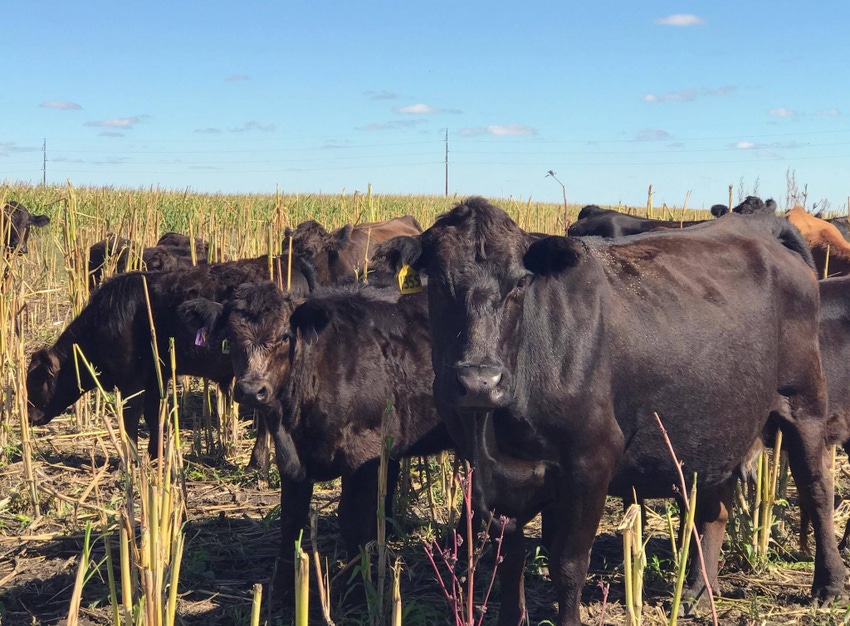New research indicates that cattlemen place a greater emphasis on conservation efforts than their farming counterparts. Here’s how cover crops, haying and cattle grazing benefit the environment and the economy.
August 1, 2018

Last week, I wrote about the economic benefits of farming and cattle grazing in an integrated system. By diversifying, we spread out our financial risks and protect ourselves against volatile markets. In the face of a trade war, this makes more sense now than ever before. Simply stated, for crop farmers looking to reduce risk, cattle might be a nice insurance policy.
READ: Building a case for increased diversity & more cattle
In addition to diversifying for financial security, there are also numerous benefits to the land when soil has a cover of grasslands or cover crops for grazing. Cattlemen are natural conservationists, which certainly goes against what the mainstream media and environmental activists would like consumers to believe.
A recent analysis of results from a 2017 South Dakota farmer survey revealed that cattlemen tend to be more focused on land conservation than their grain farming counterparts.
According to an article written Deepthi Kolady, South Dakota State University (SDSU) economics department assistant professor, for SDSU’s iGrow, “Survey results found that livestock producers were more likely to practice conservation agriculture practices, defined as no till or strip till (NTST) farming, a diverse crop rotation of more than two crops, and the use of cover crops. Compared to their non-cattle counterparts, cattlemen were 29% more likely to adopt NTST and 41% more likely to adopt a diverse crop rotation or use cover crops.”
Kolady said producers are realizing the true profit potential of cover crops and livestock integration on fields.
She writes, “Livestock integration was high among cover crop adopters, with 64% of cover crop adopters using their cover crops for grazing. The percentage was higher among farmers who used cover crops and had cattle, with 97.5% of them grazing cover crops.”
READ: Forage farming before cattle ranching
The survey, she says, indicates clear cut evidence that farmers who are also cattlemen are adopting conservation practices at a higher rate than those without cattle.
She writes, “Conservation practices are promoted as key to soil health, reduced soil erosion, improved water quality, and reduced pest pressure and chemical use, while ensuring farm profitability long-term. Thus, adoption of conservation practices has on-farm benefits for the producer and off-farm benefits for the community and the public. These are all positive environmental aspects of agriculture that seem to coincide with cattlemen, while also making an economic impact while improving diversity on farms.”
Deepthi also points out that the discussion of conservation practices followed by ranchers is a benefit that the cell-cultured protein folks would prefer to sweep under the rug. In the face of companies that would like nothing more than to disrupt traditional beef sales by disparaging conventional cattle-raising production practices, she credits livestock producers for already following a highly sustainable model that promotes soil health and has an overall positive impact on the environment.
Meanwhile on the grain side of the equation, a new program is being launched in my state that encourages farmers to plant perennial grass seeds in areas of their fields with low production due to high salinity soils. Adding grasslands to these spots slows the spread of this salty soil, promotes habitat for pheasants, butterflies and other wildlife, and offers a grazing and haying option for cattlemen following the nesting season.
READ: Soil health comes first, then grass & livestock
This program, called the Saline Soil Initiative, indicates to me that when there is cover on the soil and cattle are allowed to graze that soil, it nets a positive return on the land — something that cattlemen have always known and farmers are once again realizing. This initiative is encouraging to me, and I believe it goes hand in hand with what beef producers have been doing all along.
As ranchers, we already know that cattle grazing is “green,” but our consumers are definitely not receiving that message. It’s amazing how consumer discussions about the environmental footprint of our food really seems to center around animal protein, specifically beef, and it often feels like lettuce, tomatoes, corn cereals, almonds and their ilk get a free pass in discussions of climate change.
We’ve got a great story to tell, but between the fake meat and vegan crowds, the story is getting drowned out with the noise of their negative messaging. Our industry has a clear challenge to address, and it’s going to take a concentrated effort to turn consumer sentiments around in our favor. Surveys like the one conducted at SDSU, which indicate the ranching community’s focus on sustainable practices, are a great place to start.
The opinions of Amanda Radke are not necessarily those of beefmagazine.com or Farm Progress.
About the Author(s)
You May Also Like





